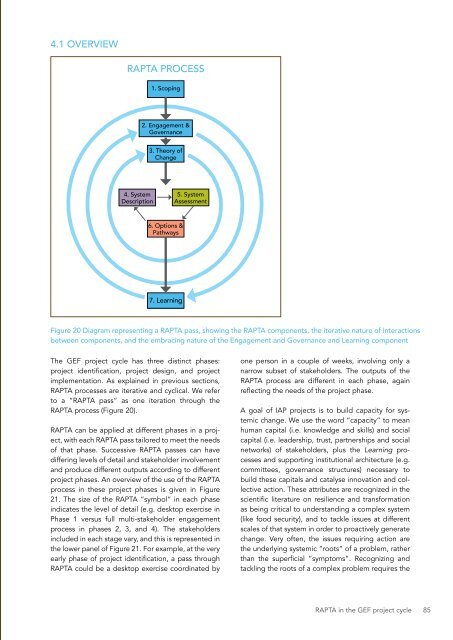DESIGNING PROJECTS IN A RAPIDLY CHANGING WORLD
srun3013fp1
srun3013fp1
Create successful ePaper yourself
Turn your PDF publications into a flip-book with our unique Google optimized e-Paper software.
4.1 OVERVIEW<br />
RAPTA PROCESS<br />
1. Scoping<br />
2. Engagement &<br />
Governance<br />
3. Theory of<br />
Change<br />
4. System<br />
Description<br />
5. System<br />
Assessment<br />
6. Options &<br />
Pathways<br />
7. Learning<br />
Figure 20 Diagram representing a RAPTA pass, showing the RAPTA components, the iterative nature of interactions<br />
between components, and the embracing nature of the Engagement and Governance and Learning component<br />
The GEF project cycle has three distinct phases:<br />
project identification, project design, and project<br />
implementation. As explained in previous sections,<br />
RAPTA processes are iterative and cyclical. We refer<br />
to a “RAPTA pass” as one iteration through the<br />
RAPTA process (Figure 20).<br />
RAPTA can be applied at different phases in a project,<br />
with each RAPTA pass tailored to meet the needs<br />
of that phase. Successive RAPTA passes can have<br />
differing levels of detail and stakeholder involvement<br />
and produce different outputs according to different<br />
project phases. An overview of the use of the RAPTA<br />
process in these project phases is given in Figure<br />
21. The size of the RAPTA “symbol” in each phase<br />
indicates the level of detail (e.g. desktop exercise in<br />
Phase 1 versus full multi-stakeholder engagement<br />
process in phases 2, 3, and 4). The stakeholders<br />
included in each stage vary, and this is represented in<br />
the lower panel of Figure 21. For example, at the very<br />
early phase of project identification, a pass through<br />
RAPTA could be a desktop exercise coordinated by<br />
one person in a couple of weeks, involving only a<br />
narrow subset of stakeholders. The outputs of the<br />
RAPTA process are different in each phase, again<br />
reflecting the needs of the project phase.<br />
A goal of IAP projects is to build capacity for systemic<br />
change. We use the word “capacity” to mean<br />
human capital (i.e. knowledge and skills) and social<br />
capital (i.e. leadership, trust, partnerships and social<br />
networks) of stakeholders, plus the Learning processes<br />
and supporting institutional architecture (e.g.<br />
committees, governance structures) necessary to<br />
build these capitals and catalyse innovation and collective<br />
action. These attributes are recognized in the<br />
scientific literature on resilience and transformation<br />
as being critical to understanding a complex system<br />
(like food security), and to tackle issues at different<br />
scales of that system in order to proactively generate<br />
change. Very often, the issues requiring action are<br />
the underlying systemic “roots” of a problem, rather<br />
than the superficial “symptoms”. Recognizing and<br />
tackling the roots of a complex problem requires the<br />
RAPTA in the GEF project cycle 85


